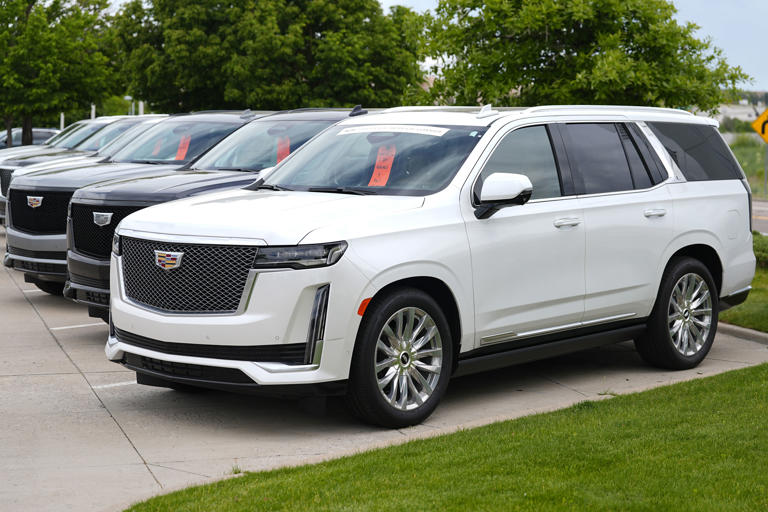General Motors (GM) delivered a strong financial performance for the second quarter of 2024, with net income increasing by 15% year-over-year to $2.92 billion. The company’s revenue for the quarter reached $47.97 billion, surpassing Wall Street’s expectations. GM’s earnings per share (EPS) came in at $3.06, beating the consensus estimate of $2.71, according to FactSet. Despite these solid results, GM’s stock fell by more than 6% in early trading on Tuesday, reflecting market reactions and underlying concerns.
Pricing and Sales Trends
U.S. customers who bought new GM vehicles last quarter paid an average of approximately $49,900. This average price is slightly lower compared to the previous year but remains competitive within the industry. GM’s pricing dynamics are influenced by a mix of factors, including changes in vehicle mix and market conditions. The company sold 903,000 vehicles to dealers in North America during the quarter, which marks an increase of 70,000 units from the same period in 2023. However, GM faced a decline in international sales, with the number of units sold dropping by 7,000 to 140,000.
Despite earlier predictions of a 2% to 2.5% decline in vehicle prices for the year, GM has revised its expectations to a more modest 1% to 1.5% decline for the second half of the year. This adjustment reflects GM’s strategy to manage pricing amid fluctuating market conditions and inventory levels. CFO Paul Jacobson emphasized that the company does not anticipate significant price cuts, even though industry analysts are forecasting growing new-vehicle inventories and increased discounts.
Market and Inventory Insights
In the broader automotive market, U.S. buyers paid an average of $47,616 per vehicle in June, which represents a 0.7% decrease from the previous year, according to Edmunds.com. Discounts per vehicle have more than doubled from a year ago, reaching $1,819. This increase in discounts is linked to a rise in new-vehicle inventory, which has grown to just under 3 million vehicles, up from about 1.8 million a year ago. While other automakers have increased their discounting practices, GM has managed to maintain relatively stable pricing and has gained market share.
Strategic Adjustments and Forecasts
Despite strong quarterly results, GM’s stock price declined, reflecting heightened investor expectations. Analyst Dan Ives from Wedbush noted that GM’s performance is indicative of a positive turnaround, highlighting the company’s focus on margins and capital efficiency. The company’s pricing stability and ability to increase U.S. market share were seen as positive factors. However, investor expectations were high, contributing to the stock’s downturn.
GM has adjusted its full-year net income guidance slightly downwards, now forecasting a range of $10 billion to $11.4 billion, compared to the previous range of $10.1 billion to $11.5 billion. The company is aiming to manufacture and sell between 200,000 to 250,000 electric vehicles (EVs) this year. To date, GM has sold only 22,000 EVs in the U.S., underscoring the need to accelerate its EV rollout. In response, GM plans to boost its marketing spending by $400 million in the latter half of the year to increase awareness and drive sales of its EVs.
Challenges with Autonomous Vehicles and International Operations
GM’s Cruise autonomous vehicle unit continues to be a significant area of concern. The company reported a $500 million investment in Cruise during the second quarter, though this was $100 million less than the previous year. GM has decided to indefinitely postpone the development of the Origin robotaxi and will focus on using next-generation Chevrolet Bolt EVs for autonomous passenger services. Cruise’s license to operate autonomous passenger transport in California was revoked last year following an incident where a robotaxi was involved in dragging a jaywalking pedestrian across a street.
Internationally, GM is facing challenges with its operations in China. Revenue for GM’s China joint venture totaled $4.7 billion in the second quarter, an increase from $4.1 billion in the first quarter but still below the $9.6 billion achieved in the fourth quarter of the previous year. Deliveries in China have been declining this year. GM CEO Mary Barra acknowledged the difficulties in the Chinese market and stated that the company is working to reduce inventory and better align production with demand. She emphasized that the remainder of the year is expected to be challenging and that GM is aggressively collaborating with its joint venture partner to address these issues.
Conclusion
General Motors’ second-quarter results reflect a mixed performance, with strong financial metrics contrasted by significant challenges in pricing, inventory management, and international operations. While the company demonstrated resilience with solid earnings and revenue growth, the stock’s decline indicates investor concerns about future market conditions and strategic execution. GM’s focus on maintaining pricing stability, managing its EV rollout, and addressing issues within its autonomous vehicle unit and international markets will be crucial for its continued success and investor confidence.
